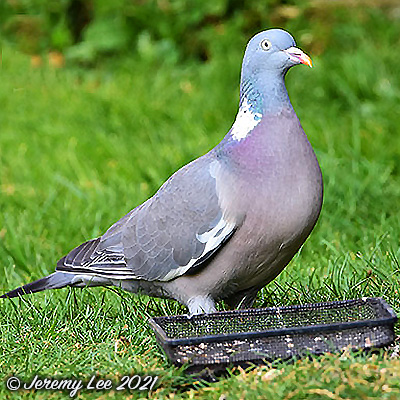
 |
|
Scientific Classifications explained » Amphibians » Ants » Aphids » Bees » Beetles » Birds » Bugs » Butterflies » Caterpillars » Damselflies » Dragonflies » Earwigs » Flies » Frog/Leafhoppers » Fungi » Galls » Grasshoppers » Harvestmen » Hoverflies » Lacewings » Ladybirds » Leaf Mines » Lichens » Mammals » Millipedes » Mosses » Moths » Sawflies » Slugs » Snails » Spiders » Trees & Shrubs » Wasps » Wild Flowers » Woodlice » Postboxes |
UK Nature > Birds > Columba palumbus

Scientific Name: Columba palumbus Common Name: Wood Pigeon Columba palumbus, more commonly known as the Wood Pigeon, measures around 40cm in length with a mid-grey head, back and wings. The breast is suffused with a mauve-pink, darker at the throat and fading to light grey underneath. There is a prominent white neck patch and, in flight, the broad white transverse bar on the upper wings, make it easily identifiable. They feed almost exclusively on seeds, grain and crops, but will feed on almost anything that is placed on a bird table. They drink more than other birds because they do not get sufficient moisture from their food. An interesting feature about how they drink is that they use their beak like a straw, whereas other birds scoop the water up and throw their heads back to let it flow down their throats. The nest is a flimsy platform made from twigs and built by both sexes in a tree or on a building. Abundant and widespread throughout the UK; seen on farmland, parkland and all types of woodland. Has spread in recent years into town parks and gardens. |
|

https://www.uknature.co.uk is a website dedicated to showing the immense diversity of UK nature and wildlife. Our vast range of habitats, from lowland arable to snow covered mountains, from storm-ravaged coastlines to peaceful inland freshwater lakes and rivers, from dry, sandy heaths to deciduous and coniferous forests, all these habitats contribute to the abundance of UK nature. We have wild birds in huge numbers either residing or visiting our shores (597 recorded species as at July 2013) and we must also not forget the humble back garden with its grass lawns, flower beds filled with nectar rich flowers, shrubs and trees, all designed to attract huge numbers of insects such as bees, moths, butterflies and hoverflies; and finally the small ponds which provide safe havens for frogs, toads, newts and even slow worms and grass snakes. www.uknature.co.uk is the showcase for my personal passion, photographing uknature in all its glory. I sincerely hope you all enjoy the fruits of my labours. This site and all images contained therein is © Jeremy Lee 2004 - 2025. All Rights Reserved. Site design by Jeremy Lee. Site development & IT Support by Stuart Lee. |